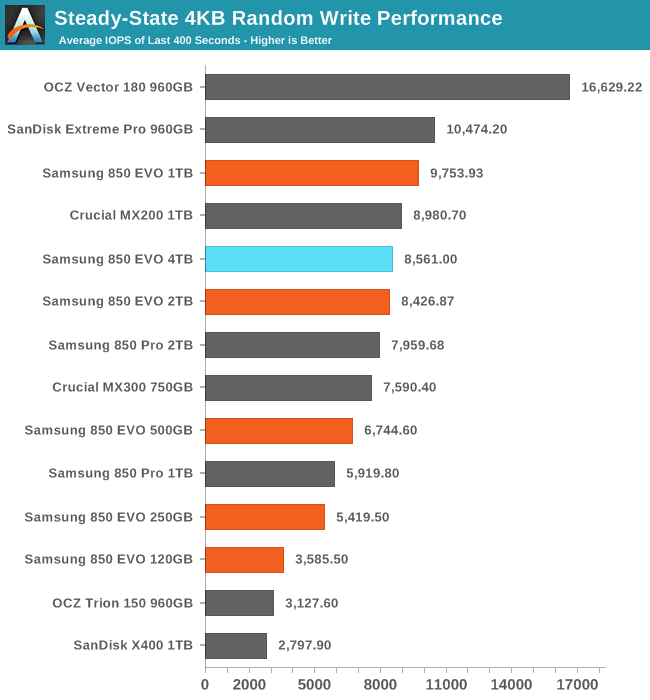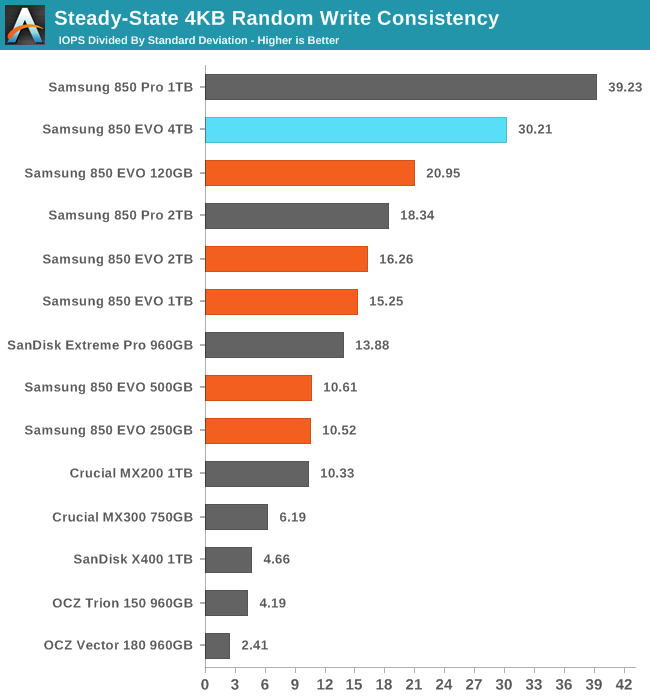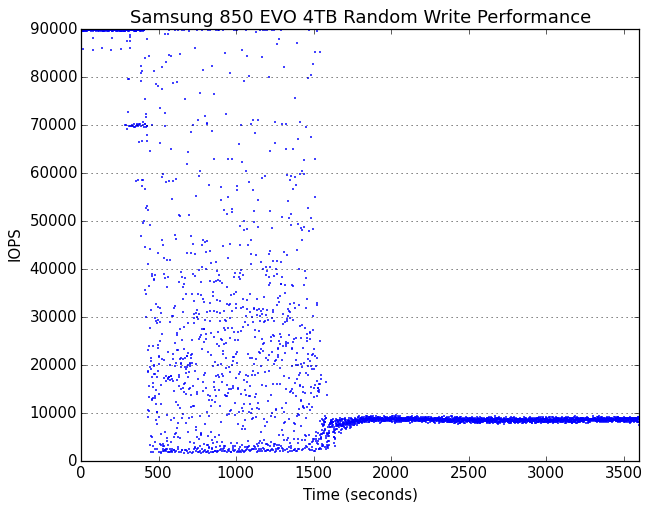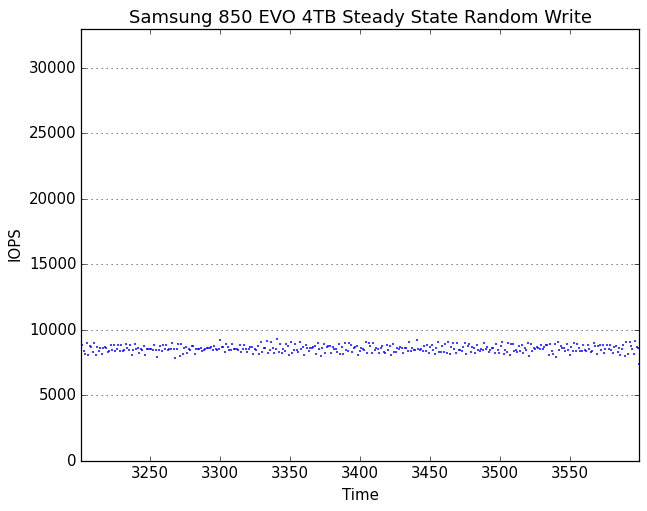The Samsung 850 EVO 4TB SSD Review
by Billy Tallis on July 11, 2016 10:00 AM ESTPerformance Consistency
Our performance consistency test explores the extent to which a drive can reliably sustain performance during a long-duration random write test. Specifications for consumer drives typically list peak performance numbers only attainable in ideal conditions. The performance in a worst-case scenario can be drastically different as over the course of a long test drives can run out of spare area, have to start performing garbage collection, and sometimes even reach power or thermal limits.
In addition to an overall decline in performance, a long test can show patterns in how performance varies on shorter timescales. Some drives will exhibit very little variance in performance from second to second, while others will show massive drops in performance during each garbage collection cycle but otherwise maintain good performance, and others show constantly wide variance. If a drive periodically slows to hard drive levels of performance, it may feel slow to use even if its overall average performance is very high.
To maximally stress the drive's controller and force it to perform garbage collection and wear leveling, this test conducts 4kB random writes with a queue depth of 32. The drive is filled before the start of the test, and the test duration is one hour. Any spare area will be exhausted early in the test and by the end of the hour even the largest drives with the most overprovisioning will have reached a steady state. We use the last 400 seconds of the test to score the drive both on steady-state average writes per second and on its performance divided by the standard deviation.

The 4TB 850 EVO restores a little bit of the performance that the 2TB lost relative to the 1TB, but Samsung's controller architecture is still clearly most comfortable at 1TB.

The consistency of the 2TB 850 EVO was only slightly better than the 1TB EVO, so it's surprising to see the 4TB model make such a large jump and come so close to the 1TB 850 Pro.
 |
|||||||||
| Default | |||||||||
| 25% Over-Provisioning | |||||||||
It is no surprise that a 4TB drive lasts so long before dropping out of peak performance: it has far more spare area to burn through than any ordinary consumer SATA SSD. The transition to steady state is uncharacteristically long and messy for a Samsung drive, and the performance lows during this period are disappointing. Once the drive has reached steady state, there's nothing to complain about.
 |
|||||||||
| Default | |||||||||
| 25% Over-Provisioning | |||||||||
There are no wild outliers from the 4TB 850 EVO's steady-state, and none of the longer-term drift in performance shown by the 1TB and 2TB 850 EVO and Pro models. With extra overprovisioning, the 4TB EVO carries on indefinitely with high and extremely steady performance.










145 Comments
View All Comments
Lolimaster - Tuesday, July 12, 2016 - link
If you "work" with 4k raw videos you can afford the enterprise level SSD's with their multi petabyte endurance rating.mapesdhs - Wednesday, July 13, 2016 - link
Exactly. I know someone who's been testing 8K editing at a movie company, he was able to get over 8GB/sec from a good Enterprise PCIe device, with consistent performance being absolutely critical. He did try RAIDs of 850 Pros but they just couldn't handle it.AnnonymousCoward - Monday, July 11, 2016 - link
Look at the graph on this page...the Samsung showed bad sectors 4 times earlier than the others: http://techreport.com/review/27909/the-ssd-enduran...3 things matter to me with SSDs: cost, reliability, and UX performance.
DPUser - Monday, July 11, 2016 - link
That was 2-D TLC. The 850 uses much more robust 3-D NAND.AnnonymousCoward - Tuesday, July 12, 2016 - link
I guess we need updated data then :)ddriver - Monday, July 11, 2016 - link
Well, that's the 840 pro - old stuff... Also, it is possible that samsung have more strict criteria of when a sector becomes unreliable and requires reallocation.Palorim12 - Tuesday, July 12, 2016 - link
But in the end, didn't the 840 Pro outlast all the other drives?hojnikb - Monday, July 11, 2016 - link
That endurance rating is simply for segmentation purposes. In reality, drive should easily reach 4PB+ of writes, before crapping out.mdw9604 - Tuesday, July 12, 2016 - link
Can you explain? I'd like to buy one for a project I am working on, if this is true.mdw9604 - Tuesday, July 12, 2016 - link
I agree. I know its EVO...but write endurance on a drive that expensive is pretty bad.